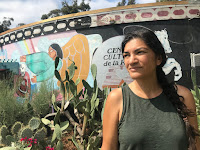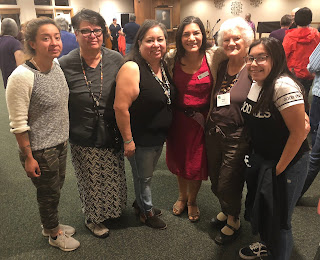Your Task is not to seek for love, but merely to seek and find all the barriers within yourself that you have built against it. - Rumi
I have been on a conscious healing journey since I was thirteen. I say conscious, because I think it began earlier, like eight, but I really sought out change when I was thirteen. When I began this journey I initially thought - there has to be something else other than the reality I have been given. This is not to say I didn't have loving parents, because I did and still do. I have two amazing human beings with world-embracing visions and a deep commitment and love for humanity who raised me. And yet, there were also deep traumas and wounds that needed attention and healing within me. Thirty years later, I find myself deep in this healing work still. Yes, I now work with others in accompanying them on their own healing journey as an intuitive healer, but I continue on my own healing journey as well. As I reflect today on this continued journey I realize it's purpose is not healing as defined by Western healing practices that treats a symptom of a malaise. It is instead a more holistic approach to healing that looks at the system, asks questions, and creates change where the system is no longer functioning to serve the human being it sustains at its highest level. What does this mean?
Here's how I broke it down in my own quest to understand what healing looks like for me today.
Our Blueprint
We are born with the nobility and gift of who we are from the start. Often, when working with clients, I ask them to consider that this noble part of who they are is still intact and somewhere within them. One of the ways I consider how this noble part might look is by making the following statement:
When the Creator thought of me, whoever the Creator thought of when He created Ymasumac, that is who I am at my essence, at my highest self.
What flows from this statement has to be love at its highest expression. Why? Because, whoever the Creator is - beyond definitions of masculinity and femininity - is a being who created the mountains, the ocean, the rivers and forests, all of this majesty...whoever this Being is, also created me. So I have to be pretty fantastic. Why is it then, that I don't feel this way? Why don't I see my majesty and nobility?
Within us our parents, family, community build a blueprint of who we are informed by their own blueprints and the forces around them. This is the task of raising a child, you put all that you have in them and as you learn more, more gets put in them. If all that I have in me is also impacted by the forces of the world around me, then some false beliefs, misconceptions and other people's beliefs about who I am inevitably become a part of this blueprint.
When you layer in trauma in your blueprint, a false sense of who you are becomes even more embedded as the emotional stranglehold of abuse settles into your bones and because of the spiritual immaturity of our current society, taboos are created around issues like sexual abuse, addiction, etc and there is no where to air out these abuses and so they settle in like truths deep in our blueprint.
When you further layer in social injustices, where entire social systems are created to subjugate one people over another, create false truths about the equality of men and women, idealize one body type over another, the impact this has on our blueprint becomes imprinted in our DNA and passed on between generations silently embedding itself into our developing psyche and sense of self.
So it is no wonder then, that we walk out of our childhood sometimes bleary eyed or with a strong sense of urgency to create change. We are so afraid to have these conversations because we don't want to disrupt the tender relationship we have with those who raised us. Who are we to question those who ensured our survival as children? Who are we to question those who with all that was within them and with all they could muster gave us everything they had? We aren't. We are questioning the false beliefs, the half truths, the lies laying wait deep within us every time we try to make a move toward our truer self, only to be shut down by guilt, control and fear - all tools of oppressors. We mistake this pain and suffering as a sign of we are doing something wrong and we run back to the comfort of what we know, rather than consider that maybe, maybe this pain and suffering is the releasing of an old shell that in its stead seeks something new.
Dismantling the Old Blueprint
And so this is healing work, at all levels, healing work is about releasing something that no longer serves us and takes us away from our truer self to place in its stead something new and closer to truth. Of course, for many of us, me included, this begins with the healing of traumas. The leftover residue of abuse never goes away, it just finds a place within the folds of our body and makes a home. And then, like toxic waste, it seeps into the tender places of our system and silently wreaks havoc. This havoc can show up as physical illness. This havoc can also show up in how we view ourselves and the things we say to ourselves. Some of the most universal falsehoods unearthed in the sacred space of healing work have been:
I'll never be good enough. No one is ever going to want me. I will always be alone. I am always going to fail. On the surface, most of us would say, no way, this is isn't true, I don't feel this way about myself. But these false beliefs are not on the surface. They are in our subconscious, a terrain we often don't visit, except in our dreams and even those sometimes terrify us.
I am not here to tell you how to heal your false beliefs or whether or not you should, that is a deeply personal decision and journey. I can only share what I have learned after thirty years of deep diving into my subconscious to unearth all those falsehoods that were placed in me sometimes by the hands of those I love most, sometimes by the hands of those who should never be trusted with the tender hearts of children and sometimes by a society that refuses to acknowledge or see the truth of who I am and builds social constructs to remind me daily that I am not enough. Whatever the case, I dove in, because I had to find another reality.
Initially, for me, healing work began to address a gnawing inside of me that something wasn't right and that I needed change. This, of course, was manifesting itself everywhere in rebellious behavior and aggressions as a teenager. As I began to do the healing work diligently with a healer once a week, I found that what I was uncovering was an entire universe within me that was built to sustain who I am. There were parts of this universe that I loved: The strength and resiliency of my ancestors, the constant presence of my grandmothers even though I had never met them in the physical world, the truth that I belonged to a universal family and that I had spiritual ancestors who had sacrificed and died for my well-being. There were also parts of this universe that manifested great pain and massive falsehoods: A sexual assault that remained hidden and forgotten by everyone except me leaving me feeling a deep void of loss and angst, a belief of not belonging as there was no social construct for who I was being I was neither Indigenous-Latina-European and with racial prejudice ripping through the core of all of this I always grew up on the outside of any community as no one would fully take me in.
These all made up part of my blueprint and the falsehoods needed dismantling as they were no longer serving me. And so I was diligent about the healing work. Focused on the dismantling. Despite the large impact it had on my familial systems, I continued, because I could not live with a full sense of who I was so long as who I was was defined by a mirror covered in dust. When we dismantle old blueprints, everyone gets challenged. Not outrightly, after all, it is my healing work, not theirs. But my behaviors change, my perceptions shift and this impacts my outer reality and relationships. And so much of it is in a mode of growth and learning, which means lots of mishaps and mistakes are made - by everyone - and this requires a strong sense of resiliency, tolerance and acceptance - by everyone, but mostly by me. There were some steady forces that held through the healing process - for me primarily my sister, mother and husband - they didn't understand my healing work most of the time, but they were resilient, tolerant and accepting of me and my path and this I began to realize, became a new teacher for me...
While simultaneously dismantling an old blueprint, I was also building a new one.
Building a New Blueprint
We cannot take away something and not put something new in its stead. Something always grows and develops in the absence or removal of something else. What is important is that whatever grows in the place of what was removed, be done thoughtfully and with purpose. And so, as I dismantled this
 |
| Author in a state of convergence |
old blueprint, I realized I was building up a new one at the same time. Maybe not at the same rate and at times I felt rather lost. I knew the old way of doing things wasn't an option, but there wasn't anything clearly in front of me to put in its place. This place is where we most develop our spiritual qualities and attributes, which become cornerstones in our new blueprint.
Spirit time is different than time in a material realm. Spirit time can feel slow and then all of the sudden it is too fast! So it requires different feet to walk with and a different sense of time. It requires a deep abiding trust that there is a force in this universe - that many of us have defined as the Creator - that ultimately wants our highest light to come forth. This trust stretches us out, asks us to love deeper, hold on longer and be present more, because when growth manifests itself, sometimes it can be all at once and that can require humility and gratitude to keep holding the steady pace of what I have come to now know as love.
So love becomes the foundation of my new blueprint, real love. Not love that demands expectations or rewards for hard-work. Not love that says I did this, so you do that. Not love that says success looks like this and anything short of this is failure. It is a love that has long-vision, that demands more of us and yet nothing at all, that sees us completely and knows where there's more need of growth, it's a love that exists outside of false dichotomies and in the place of constant search for truth...it is a love that is absolute.
When the Healing is Done
As I opened up new wounds, let go of pent up emotions, processed through the hard trauma abusive systems can leave in place, released false beliefs and cleared out this old blueprint; I steadfastly in its place put new truths of wholeness, nobility, faith, and a new kind of love and compassion, transformation came slow and than all at once.
Recently, I was given an opportunity to straddle two worlds at once: Building and constructing my life's calling through writing, healing and education and serving my Faith community full-time. Neither of these are exclusive, they inform each other all the time. As a Baha'i, I have a faith community that asks us to grow constantly and release old belief systems that no longer serve us or humanity. It asks us to use tools like consultation and to carry qualities like a humble posture of learning in all that we do. As I reflected on the opportunity before me, my heart sang, my home-base supported me - so why then, was I wracked with deep pangs of guilt and fear? It was here that I realized, the continuous work of wrestling with the forces of disintegration and integration. These destructive and constructive forces are happening all around us as we see old systems become quickly dismantled and new ones painstakingly built in its stead. For example, in education the old system of educating through a teacher that stands at the helm of learning to impart knowledge on their students is quickly giving way to a new and developing system where the teacher serves as a guide and facilitator of learning, while students become active agents of their own learning. What this demands is not only a release in structure, but in how teachers and students carry themselves, the qualities they exhibit and express need to shift dramatically. This can cause confusion, chaos and upend emotions distilling a lot of fear and pain as the disintegration and integration process takes place.
So too was this new opportunity upending emotions, creating confusion and chaos in an old blueprint that doesn't understand the new reality I'm walking into. I have to say, I too don't know the new reality I'm walking into, but I am utilizing all of the tools I have been building into my new blueprint to help me with this walk. As I accepted this opportunity, forces from my old blueprint welled up inside of me and around me questioning all of my choices, going back years, unearthing false beliefs and norms of behavior. This old blueprint uses tools like guilt and fear to wrangle back control and compliance. This old blueprint, heavily impacted by colonization, does not believe we are noble human beings with the universe folded within us and if it attempts to entertain this idea, it only does it in theory, not as a reality we walk daily. Once I realized these feelings I was having were just the natural outcome of the destructive forces disintegrating and the constructive forces integrating within me, I was able to release and allow the process to happen.
Today, I understand that this healing work is not just about the releasing of the old blueprint that keeps so many of us captive in a colonized past where nobility is based on material wealth and bloodline. It is also a sacred act, where the healing of the false beliefs of the past, release our ancestors from this bondage and ensure the future generation can take their righteous place among the noble ranks of humanity.















